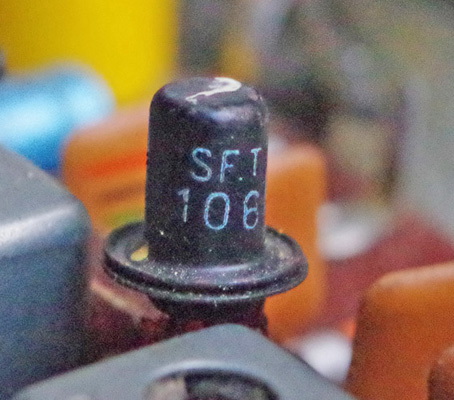Compared to other countries, the history of early semiconductor manufacture in France is somewhat obscure. Finding original devices and contemporary data books or sheets about them is difficult. However, there are some other sources:
- Google Books contains "A History of the World Semiconductor Industry" by P.R.Morris. Unfortunately, the pages on early French efforts are deliberately omitted! However, a correspondent has sent me scans of them, and they contain almost nothing about the industry prior to integrated circuits.
- Fortunately, another enthusiast, Mark Burgess, has created this Web page. I will avoid repeating his information as much as possible.
- Two useful sources of early device data (and dates) are the books by Derivation and Tabulation Associates (D.A.T.A):
You can view and download those in full from the links above.
The start of the French industry was simple because it was dominated by two commercial firms:
- Possibly the first commercial junction transistors in France were made by the Compagnie Générale de télégraphie Sans Fil (CSF), although they did not seek a license from Bell Laboratories nor any arrangement with RCA unlike many of the early manufacturers.
- The other major French manufacturer of semiconductors was the Compagnie Française Thomson-Houston (CFTH) who were in fact a subsidiary of the General Electric Company of the USA.
Things subsequently became complicated in terms of company structures:
- In the mid 1950s CSF created a semiconductor manufacturing wing called the Compagnie Générale de Semi-conducteurs (COSEM).
- In 1961 CFTH formed a joint venture with General Electric, the Société Européenne des Semi-Conducteurs (SESCO).
- In 1966 CFTH merged with Hotchkiss-Brandt to form Thomson-Houston-Hotchkiss-Brandt (soon renamed Thomson-Brandt).
- In 1968 the electronics business of Thomson-Brandt merged with CSF to form Thomson-CSF.
- In 1969 SESCO and COSEM merged to form SESCOSEM.
- In June 1987 the Italian company SGS (Società Generale Semiconduttori) merged with Thomson Semiconducteurs to form SGS-Thomson.
- SGS-Thomson was renamed STMicroelectronics in May 1998.
COSEM, SESCO, Thomson-CSF and SESCOSEM brands can all be found on germanium transistors. I'm unsure about Thomson-Brandt. SGS Thomson made germanium devices, and eBay usually has some that are claimed to be from STM, however this last is probably too late to be of interest to historic device collectors.
Another lesser-known manufacturer was Silec, the Société Industrielle de Liaisons Électriques, founded in 1932 in Paris. It was primarily concerned with cables, and played a major role in establishing traffic lights in France. In the late 1950's it did branch out into semiconductors, which were manufactured under the name of Silec-Semi-Conducteurs (SSC). I only have some 1970's catalogues, which list a large number of Zeners, rectifiers, thyristors, triacs, diacs and other semiconductor devices including a few power transistors and unijunctions, all made of silicon. I'm slightly doubtful that all these types were internal manufacture, and would not be surprised if they had a licensing arrangement with a US manufacturer. I would be very interested to see an early catalogue, and specifically whether they sold any germanium products.
I am seeking many early French transistors and semiconductor diodes, as listed below in the text. If you know where I might obtain these, please
Je cherche des exemples des premiers transistors français et des diodes semi-conductrices, énumérés ci-dessous dans le texte. Je cherche aussi des bouquins de donnéés contemporaines. Si vous savez où je pourrais les obtenir, prière de

There is one momentous historic event that took place in France, although it went unrecognised at the time and was not followed by commercial exploitation. A German physicist invented the point-contact transistor completely independently of Bell Labs.
This link provides details of this amazing achievement.
I am seeking examples of the transistron. If you know where I might obtain any, please

Mark's article does not give exact chronology, but states that the Laboratoire Central de Télécommunications (LCT) produced two point-contact transistors, types 3698 (switching) and 3768 (general use). These used the typical 'type 1' plug-in cartridge case originated by Bell Laboratories in the USA.
LCT also made some early junction transistors, for example the type 3604 and 3609.
I am very keen to obtain examples of any LCT transistors. If you know where I might obtain any, please
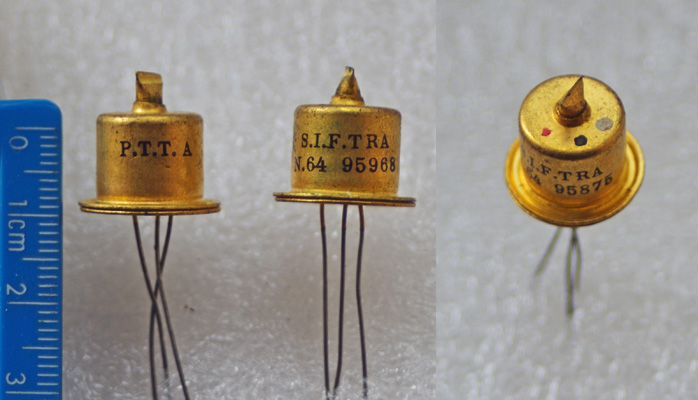
A second little-known and poorly-documented semiconductor development took place in France. My image shows some devices marked S.I.F. TRA N.64 plus a 5-digit number that varies from device to device. A Web search returns only a single hit - a French blog entry. The Société Industrielle Francaise des Transistors was created around 1956-1957 by CNET for the development of french transistors with major telephone companies (SAT, TRT, LTT and others) for use in undersea cables and professional telephone equipment. The image on the blog shows that S.I.F. called their devices "transistrons" just like the Westinghouse F&S point-contact types. They bear a striking resemblance to early junction types from Western Electric. The box shown on the blog is handwritten "Type: 7700 623" and the part number of these devices is known to be 7700, even though it is not printed on the transistors themselves.
The origin and usage of this transistor is quite mysterious. If you can provide more information about it, please
L'origine et l'utilisation de ce transistor sont assez mystérieuses. Si vous pouvez fournir des informations à ce sujet, veuillez me
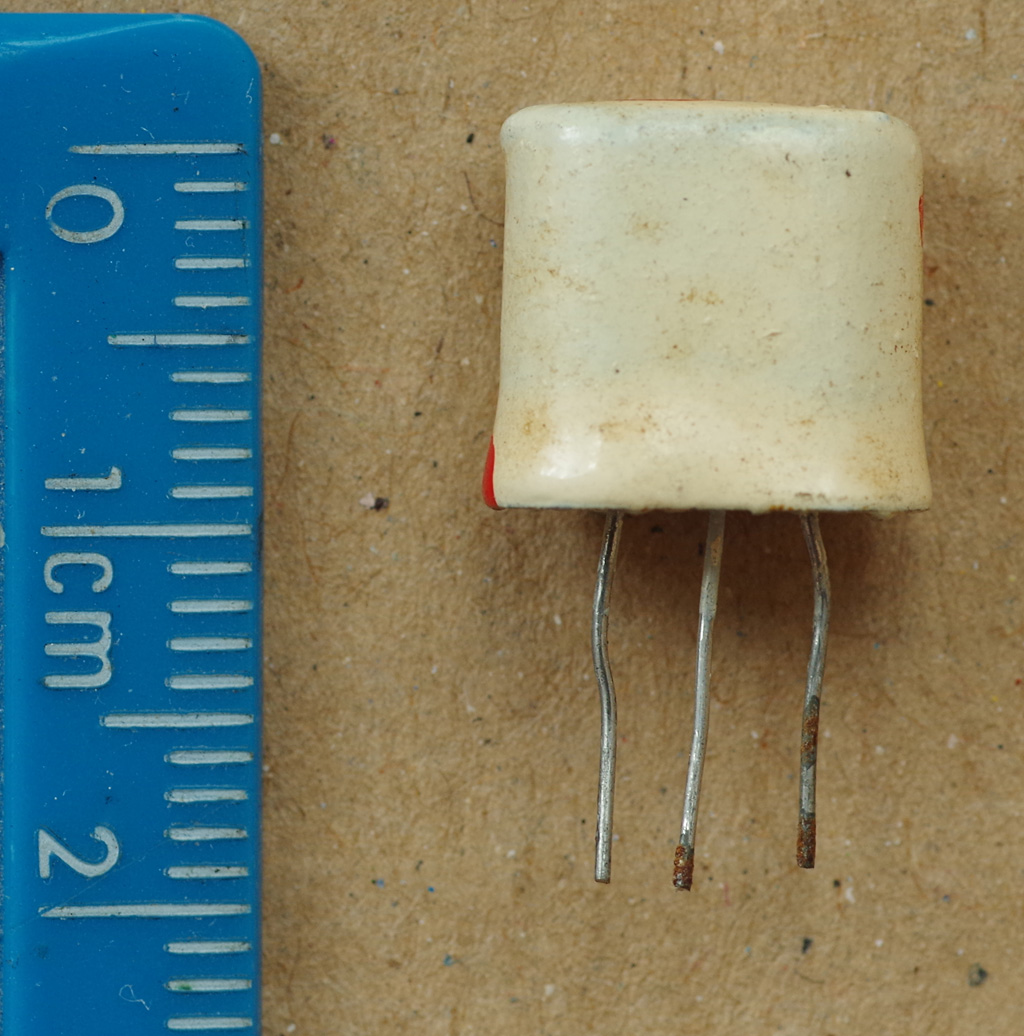
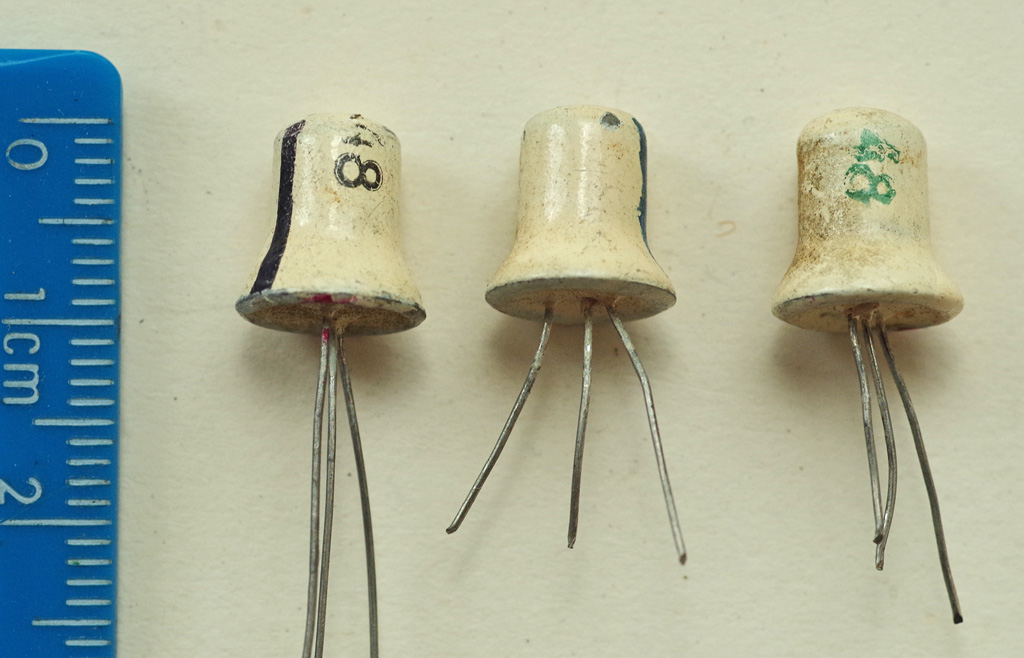
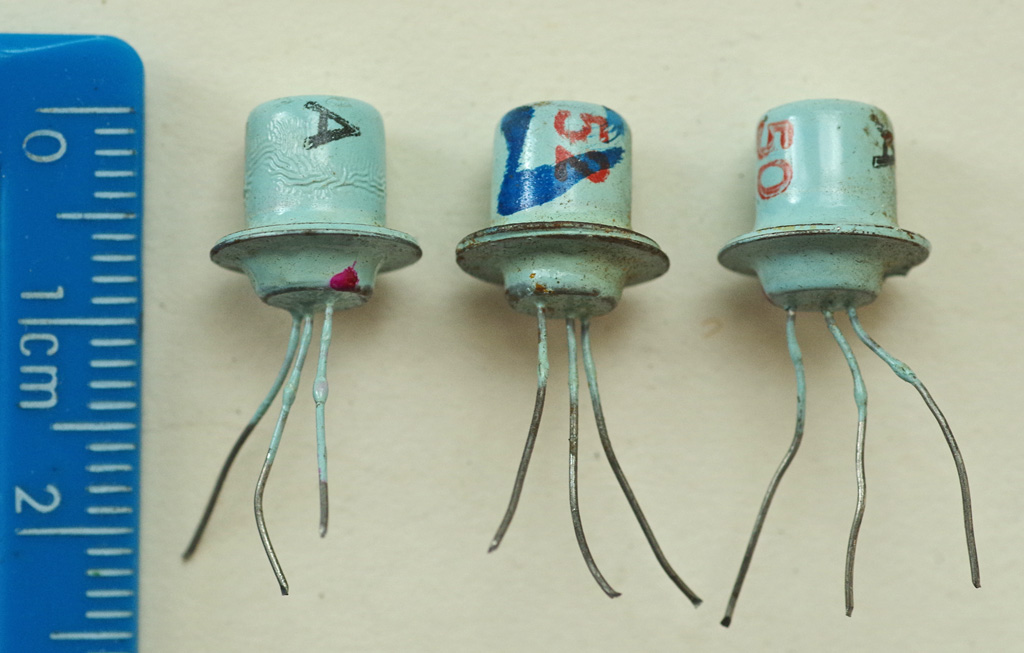
I have obtained some very early French transistors, shown in these three images. They do have some numbers or letters on them, but no clear part number or manufacturer identification. The blue ones and the oval one closely resemble the CSF transistors found in the Solistor Transistor 8 radio, made by Clarville , Paris, starting in 1956. Radiomuseum lists the identification letter on the Solistor transistors:
Mine have the letter A, B, F or G on the top, suggesting that they are indeed from a Transistor 8. The cream-coloured ones in the middle image also strongly resemble the CSF TJN3 shown on radiomuseum, which may be a later public name for one of the types.
If you know more about these transistors, please

The first transistors made by CSF, the TJN1 and TJN2, were produced by the Recherches Physico-chimiques laboratory (RPC) at Puteaux. They went on to make a few more types in the TJN series, up to about TJN7, and one power transistor: TJN100.
I am very keen to obtain examples of any TJN transistors. If you know where I might obtain any, please

By 1959 CSF had dropped the TJN series and was producing PNP germanium junction transistors in the SFT series (although in fact there is a dot between the SF and the T thus SF.T) and diodes in the SF.D series. The earlist of these transistors use bell-shaped cans, painted black.
I am keen to obtain original examples of SFT101 to SFT104. If you know where I might obtain any, please
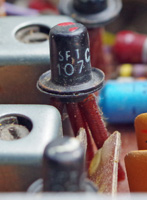
Later examples in the series such as this SFT107 use a tall 'top hat' shape, still painted black, and with a curious double-edge to the rim.
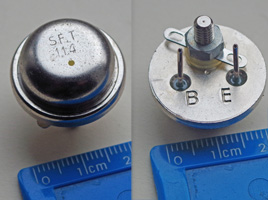
Some low-numbered SFT power transistors were made, such as this SFT114 in a circular domed case just over 2 cm in diameter. Early examples are marked CSF, but my example was in SESCO packaging (see below).
I seek examples of any transistors branded CSF. If you know where I might obtain any, please
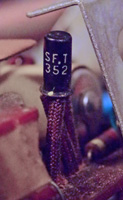
Later SFT series types such as this SFT352 use a fairly standard TO-1A package, still painted black.
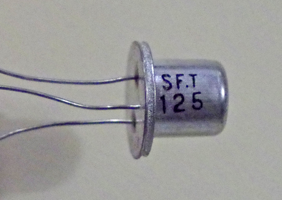
This 350mW SFT125 is not painted but still has the double-rim.
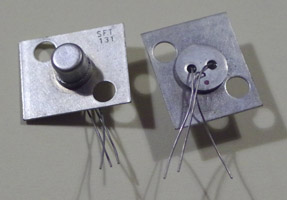
Some such as this 1.33 Watt type SFT131 have a heatsink fin fixed around them.
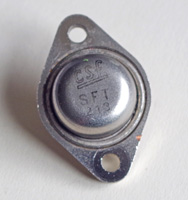
This SFT213 employs the standard TO-3 package, although it is branded CSF which suggests that it is an early example.
One aspect of the SFT series that puzzles me is that an apparently-equivalent EFT series exists, made by the company IPRS Baneasa in Romania. How this commercial arrangement came to be is a mystery to me, if you know about it, please
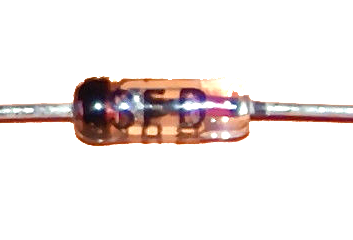
I have a COSEM booklet on diodes dated 1968. It contains a good number of germanium and silicon diodes: tungsten diodes, gold-bonded diodes and junction diodes. They are assigned to many series: 1N, SF.D, AA, FS., AAY, AAZ, BAY, DB and SF.R. There are also multi-diode devices and stacks, plus two germanium photodiodes PHG1 and PHG2. Many of these diodes use the miniature DO-7 glass encapsulation like the general purpose SF.D108 (much magnified) in my image.
A second booklet also dated 1968 lists UHF diodes. It contains a good number of silicon varactors, PIN diodes, GaAs parametric diodes, UHF switching silicon diodes, germanium tunnel diodes and silicon 'snap off' diodes. All of these are assigned to the SF.D series.
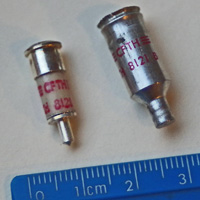
CFTH started making silicon point-contact microwave diodes in the early 1950s. My image shows a TH8121B in the classic plug-in cartridge with its protective anti-static casing. This type is one of a series of ten numbered 8021, 8121, 8023 and 8123 plus various suffixes. The part numbers ending in 21 are equivalent to the American 1N21, and those ending in 23, to the 1N23.

CFTH also made four "low-level detector" silicon diodes: TH8031, TH8032, TH8131 and TH8132. I think they were equivalent to 1N31 and 1N32. I believe they look like the above 8x2x types but I would be interested in information about or examples of them. If you know where I might obtain any of these, please
CFTH then made many germanium and silicon diodes, although I'm unsure of the chronology but the following are listed in the 1961 D.A.T.A book (see above). There are several series:
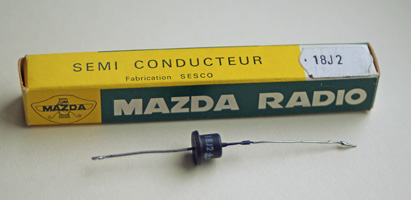
The image shows a SESCO-branded 18J2 in a MAZDA RADIO box. I have a similar 16Z4. I would be interested in information about or examples of the THP series diodes. If you know where I might obtain any of these, please
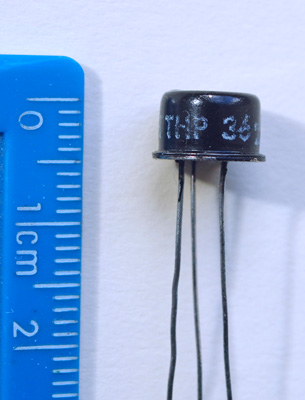
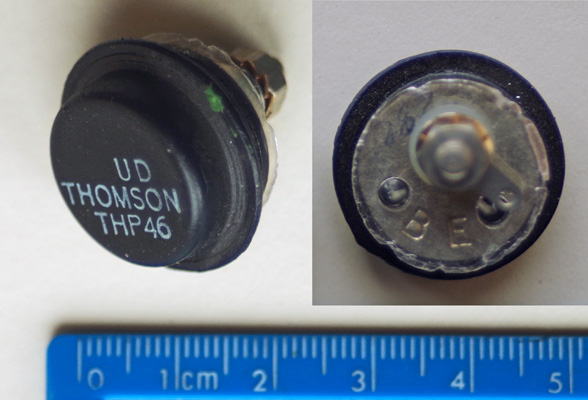
For what seem to be political reasons, CFTH got off to a relatively slow start in transistors. In 1956 they advertised a single power transistor TH8501, and by 1958 they had started their own THP series. I have a scanned copy of an article in 'Le Haut Parleur' 30 October 1959 entitled 'Characteristics of the Principal Transistors manufactured in France' that lists the following THP types:
The 1962 D.A.T.A. book (see above) adds:
My images show the THP36 and THP46.
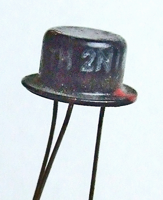
They were manufacturing GE types from the American 2N series. The 'Le Haut Parleur' article lists the following CFTH 2N types:
The image shows a 2N186, printed TH rather than THOMSON.
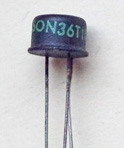
They also had a a series that has a numeric prefix of two or three digits followed by the letter 'T' and then a numeric suffix such as this 36T1. The 1962 D.A.T.A. book (see above) also includes the following series:
Information from the radiomuseum site shows that, by about 1960, they were also using in commercial radio manufacture:
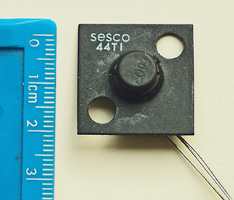
This is a Sesco 44T1 in the same case with integral heatsink as the SFT131 above.
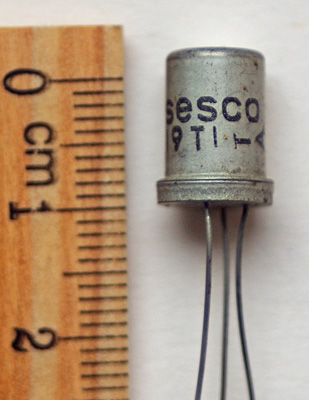
This Sesco 19T1 in a tall cylindrical case is a bit of a puzzle. The 1962 D.A.T.A. book lists 17T1 and 18T1 but no 19T1, and it is not found in later databooks either. If you have data for it, please
I am keen to obtain original examples of CFTH transistors and diodes, especially:
If you know where I might obtain any of these, please
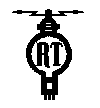
Another early French manufacturer was La Radiotechnique, which was owned by Philips of the Netherlands, the biggest manufacturer of germanium transistors in Europe. I do not believe that La Radiotechnique was as important as Philips' other two European manufacturing subsidiaries, Mullard and Valvo. La Radiotechnique used this logo on its thermionic valves/tubes: a transmitting tube with the letters RT inside it.
If you know anything about La Radiotechnique semiconductors, or where I could get some, please
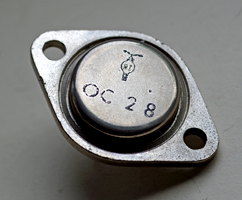
After more than 30 years of collecting, I have only ever seen the RT logo appear once on a semiconductor, the OC28 germanium power transistor on the right. However I also have an IC of theirs where only the letters RT are used.
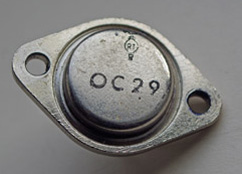
Well, just like buses ... only a few weeks after publishing the above I was able to buy another RT germanium power transistor, OC29 this time, on eBay.
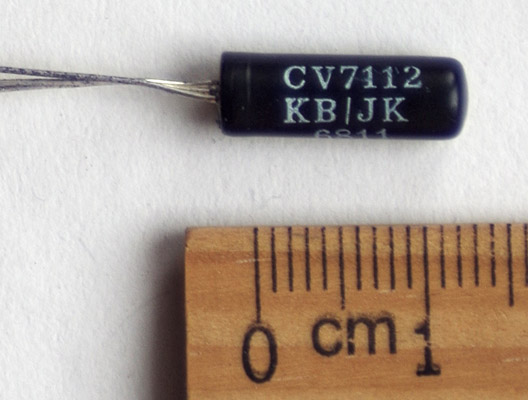
And this device is most unusual. It's a UK military CV-series type CV7112, which is equivalent to a Philips-group OC140 germanium NPN junction transistor used as a low-power switch. What is extraordinary about this example is the factory code JK, which stands for La Radiotechnique, Suresne, Paris. Why was RT making UK military devices in 1968? Perhaps Mullard did not have sufficient capacity for an order and got RT to help?
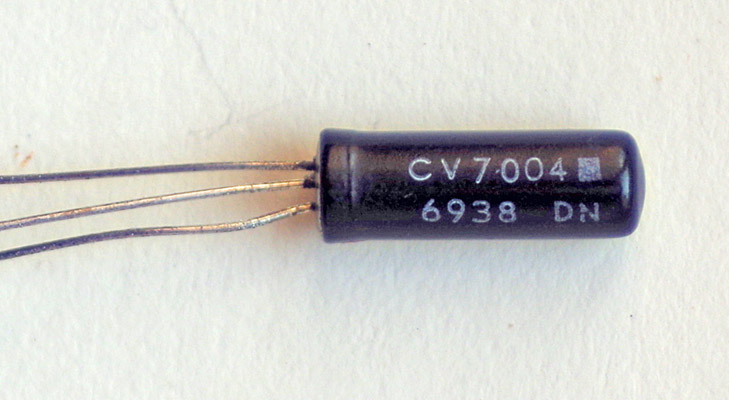
And I have recently discovered that RT had a second CV-series factory code: DN for a factory in Caen, as shown on this type CV7004 dated 1969.
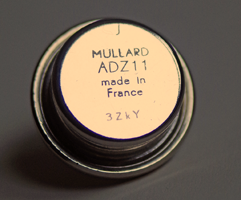
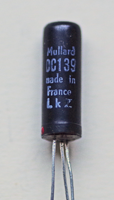
Mark's Web page does not mention that a small number of germanium transistor types, branded for the English company Mullard, were manufactured in France, as proven by printing on them. I show an ADZ11 power transistor and an OC139 in the classic SO-2 glass tube. In fact, Philips/Mullard had factories in very many countries, but only a few seem to have made semiconductors. In France, Philips used the factory of the Compagnie Industrielle Française des Tubes Electroniques "CIFTE", 1 Place Herold, Courbevoie Seine, just outside Paris. I was informed of this by a correspondent, who also provided me with an explanation of Philips' device codes, now listed on the Web.
Unfortunately, the codes on my transistors, 3ZkY and LkZ, do not match in any obvious way the information in that document!
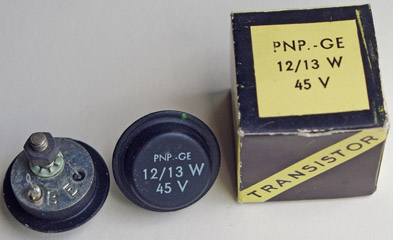
I bought these power transistors in original boxes on a well-known auction site. The vendor stated that they were sold by Radio-Prim, and were similar to SFT114. Thanks to Jean-Louis I know that Radio-Prim was a retail shop based in Paris that, in the late 1960s, sold spare parts for radio enthusiasts, not unlike Henry's Radio or many shops in Edgware Road or Tottenham Court Road in London. They advertised regularly in 'Le Haut-Parleur'. They renamed some of the transistors they sold, for example a '71 A' would be a first grade equivalent to the well-known OC71 made by Mullard or Philips/ La Radiotechnique. A '71B' would be a second grade OC71 (less expensive), and a '71R' (cheaper still) would be little more than a reject, the 'R' standing for 'Reclamé'.
If you know where I might find other Radio Prim transistors, please
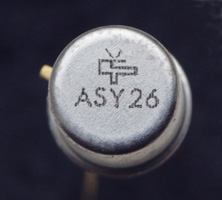
I won't show any later types, except this SESCOSEM ASY26 which displays their stylised transistor logo. However many rather pedestrian germanium types with pro-Electron numbering were made by COSEM, SESCO and SESCOSEM. Examples can be found on eBay, although vendors often specify the incorrect manufacturer, not surprising considering the messy history shown above.
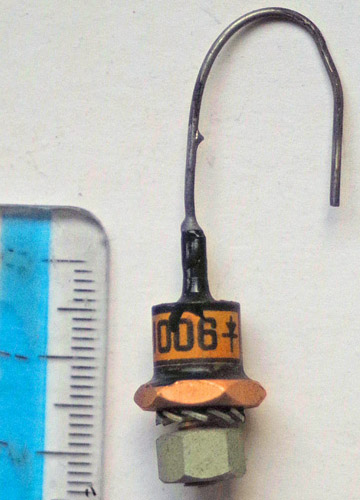
There are diodes made by SILEC for sale on eBay and nearly all use modern outlines. I possess this rather retro-looking SILEC diode type P1006. It is in the SILEC Catalogue 1977 as a silicon rectifier diode, 6 Amperes, 100 Volts. The outline is denoted S95a.
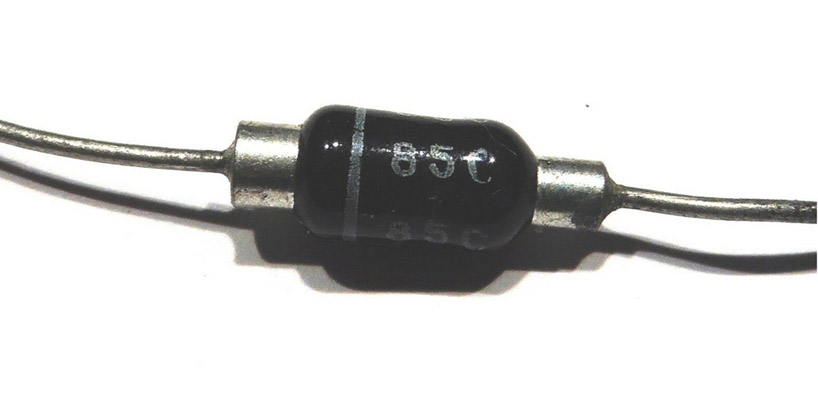
I also have this SILEC diode 85C for which I have no data.
If you have data or information about it, please

I have serendipitously come across vintage diodes made by SORAL, the Société Radio-Lyon based in Paris. Radiomuseum's company description lists their valves/tubes, but no semiconductors. However, the site does contain data for their silicon diodes. These come in several series:
A Web search reveals selenium rectifiers and some of those silicon diodes. Did they try germanium first?
If you have databooks or information about their semiconductors, please
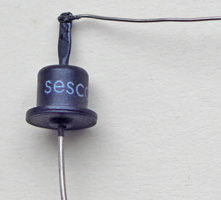
This diode is a puzzle. It is simply printed SESCO, nothing else. No part number in particular.
If you have data or information about it, please
